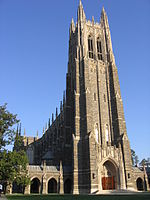- Duke Lemur Center
-
Duke University campus 
Duke Lemur Center Use To promote research and understanding of prosimians Style N/A Erected 1966[1] Location 3705 Lemur Lane
Duke ForestNamesake Duke University Architect N/A ' Website lemur.duke.edu The Duke Lemur Center is an 85-acre (34 ha) sanctuary for rare and endangered prosimian primates, located at Duke University in Durham, North Carolina. It is the largest sanctuary for prosimian primates in the world.[1]
The Duke Lemur Center is open to the public through tours, for which visitors must make an appointment.[2][3]
History
In 1966, a prosimian colony of approximately 90 individuals, belonging to John Buettner-Janusch, was relocated from the Center for Prosimian Biology at Yale University to Duke University, creating the Duke Lemur Center (DLC). Through the 1970s the colony grew to approximately 700 individuals representing 33 species. The current colony ranges between 250 and 300 animals, representing approximately 25 species. Originally called the Duke University Primate Center (DUPC), the center's name was changed in April 2006 after a refocusing of the scientific goals and overall mission. Specimens from its scientific collection may thus be assigned the code DPC.[citation needed]
The mission of the Duke University Lemur Center is to "promote research and understanding of prosimians and their natural habitat as a means of advancing the frontiers of knowledge, to contribute to the educational development of future leaders in international scholarship and conservation and to enhance the human condition by stimulating intellectual growth and sustaining global biodiversity."[1]
The Lemur Center, the only university-based facility in the world devoted to the study of prosimian primates, is home to the world's largest colony of endangered primates, including more than 250 lemurs, bush babies and lorises. More than 85 percent of the center's inhabitants were born on site.[citation needed]
In 1997, the center began a program to reintroduce Black-and-white Ruffed Lemurs into the 5,500-acre (2,200 ha) Betampona Natural Reserve in Madagascar, the first return of any prosimian primates to the island nation.[4]
In 2009 and 2010 the center completed two new buildings for housing lemurs. The first building was completed in 2009, and is a 14,922-square-foot (1,386.3 m2) facility (including exterior animal runs) with 7,056 square feet (655.5 m2) of interior space. It can house up to 60 animals that can be released into the 69-acre (28 ha) Duke Forest if weather permits. The second building was completed in 2010 and is a 20,637-square-foot (1,917.2 m2) facility (including exterior animal runs) with 9,883 square feet (918.2 m2) of interior space. Together they can house 140 lemurs. The buildings are designed with animal housing wings radiating from a central core which houses common resources like laboratories, exam rooms, food prep, bathrooms, and storage spaces. Both buildings are designed for low water and electricity use, and are LEED registered. The total cost of the two-buildings, designed by architects Lord, Aeck & Sargent of Chapel Hill, North Carolina, was $10.4 million.[5]
References
- ^ a b c "About the Duke Lemur Center". lemur.duke.edu. Duke University. http://lemur.duke.edu/about-the-duke-lemur-center/. Retrieved 27 May 2011.
- ^ "Directions". lemur.duke.edu. Duke University. http://lemur.duke.edu/about-the-duke-lemur-center/directions/. Retrieved 27 May 2011.
- ^ "Betampona Reserve and the Ruffed Lemur Re-stocking Program". lemur.duke.edu. Duke University. http://lemur.duke.edu/tours/. Retrieved 27 May 2011.
- ^ "Tours". lemur.duke.edu. Duke University. http://lemur.duke.edu/betampona-reserve-and-the-ruffed-lemur-re-stocking-program/. Retrieved 25 July 2011.
- ^ "Duke Univ., Duke Lemur Center, Durham, N.C.". Laboratory Design Newsletter. 15 February 2011. http://www.rdmag.com/Lab-Design-News/News/2011/02/New-Projects-Duke-University-Duke-Lemur-Center. Retrieved 25 July 2011.
External links
- Official website
- Duke University
- Nature: The Loneliest Aniamls (Chapter 4): Lemur survival in captivity at the Duke Lemur Center
Zoos, aquariums, and aviaries Types of zoos Conservation Lists Animals Other topics - Animals in captivity
- Animal training
- Behavioral enrichment
- Captive breeding
- Frozen zoo
- Immersion exhibit
- Nocturnal house
- Wildlife conservation
- Zookeeper
- Zoology
- Portal
- Project
- Category
- Commons
Zoos and aquaria of North Carolina Aquariums Zoos - Duke Lemur Center
- JB's Rattles Traveling Reptile Zoo
- Museum of Life and Science
- Natural Science Center of Greensboro
- North Carolina Zoo
- Triangle Metro Zoo
- Western North Carolina Nature Center
Categories:- Primate research centers
- Duke University
Wikimedia Foundation. 2010.

